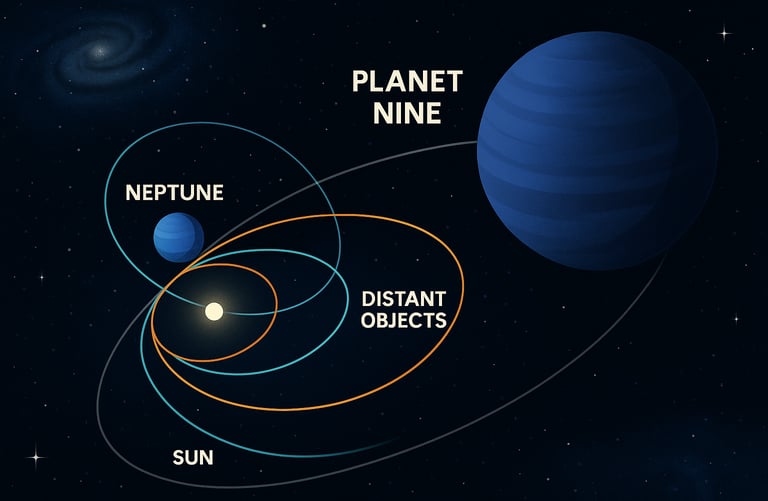Do You Know About the Strange Pattern of Distant Objects Beyond Neptune
#PlanetNine, #BeyondNeptune, #TransNeptunianObjects, #KuiperBelt, #DistantSolarSystem, #SpaceMystery, #AstronomyNews, #OuterSpace, #TNOs, #HiddenPlanet, #FaroutObject, #ScienceDiscovery, #Distant Objects
KNOWLEDGE & EDUCATION
8/1/20252 min read


Our solar system is full of mysteries, but some of the strangest lie beyond Neptune—in the cold, dark edge of space known as the Kuiper Belt. In recent years, astronomers have discovered distant celestial objects that behave in an unexpected way—they follow oddly clustered orbits, as if something massive is pulling on them.
Could this be the evidence of a hidden planet, or is there another cosmic force at play?
1. What Are These Distant Objects?
Beyond Neptune lies a zone filled with icy rocks, called Trans-Neptunian Objects (TNOs). Some of these are:
Sedna
2012 VP113
Eris
Orcus
These objects are extremely far—over 30 to 1000 times farther from the Sun than Earth. They follow strange, elongated orbits, tilted at unusual angles.
2. The Pattern That Puzzles Scientists
Many of these distant TNOs appear to have orbits that point in the same direction and lie on the same plane—a strange pattern that should not happen if only the known planets were influencing them.
It’s like a group of cars all driving in circles—but always turning at the same point. This is highly unlikely by random chance.
3. The Planet Nine Hypothesis
In 2016, astronomers Konstantin Batygin and Mike Brown from Caltech proposed a groundbreaking theory:
A massive, unseen ninth planet—about 5 to 10 times the mass of Earth—is hiding far beyond Neptune and gravitationally shepherding these distant objects.
They named it Planet Nine (not Pluto, which was demoted to a dwarf planet).
This hidden planet, if real, would take 10,000 to 20,000 years to orbit the Sun and might lie 600 to 1,000 AU (astronomical units) away.
4. Is It Really a Planet? Or Something Else?
There are two main camps in science:
Pro-Planet Nine scientists believe a large planet explains the orbital patterns best.
Others argue that the strange orbits might be the result of:
Interactions with smaller icy bodies over millions of years
A disk of dark matter
Gravitational effects from a passing star in the distant past
Still, no telescope has directly spotted this mysterious object.
5. Latest Research and Observations
As of 2025:
Advanced telescopes like Vera C. Rubin Observatory and James Webb Space Telescope are scanning the far reaches of the solar system.
Several new TNOs have been discovered, which support the Planet Nine theory—but it's still unconfirmed.
One of the most recent objects found, nicknamed “Farout”, lies over 120 AU away—making it the most distant known solar system object to date.
6. Why This Matters to Us
Understanding these patterns helps us:
Map the true size and shape of our solar system
Discover how planets formed and migrated
Test new physics theories
Possibly uncover the next big planetary body in our cosmic neighborhood
Conclusion
The strange pattern of distant objects beyond Neptune may be the biggest celestial clue of our time. Whether it leads to the discovery of Planet Nine, a new understanding of gravity, or a mystery even deeper—it reminds us that space still holds many secrets. The edge of our solar system isn’t the end—it might be the beginning of something bigger.
Knowledge
Empowering minds with reliable educational content daily.
Newsletter Signup
© 2025 DoYouKnow. All rights reserved.
Stay Ahead of the Trends – Join Our Newsletter
